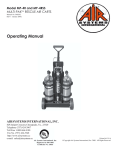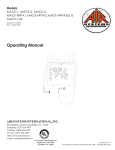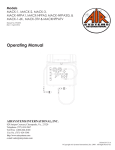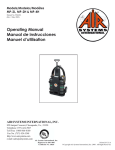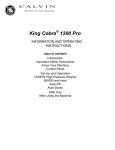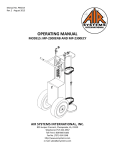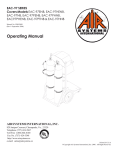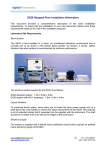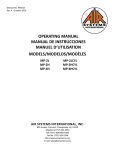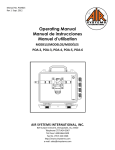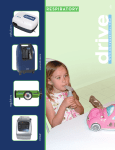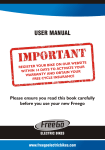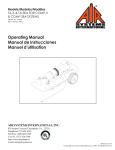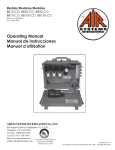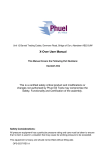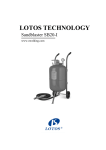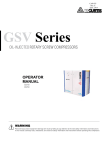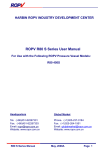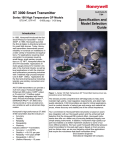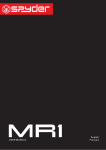Download PAK-4 & PAK-4R - Air Systems International
Transcript
Models PAK-4 & PAK-4R Manual No. PAK002 (Rev 6 February 1999) Operating Manual AIR SYSTEMS INTERNATIONAL, INC. 829 Juniper Crescent, Chesapeake, Va. , 23320 Telephone (757) 424-3967 Toll Free 1-800-866-8100 Fax No. (757) 424-5348 http://www.airsystems.cc e-mail: [email protected] Printed in U.S.A ©Copyright Air Systems International, Inc. 2000. All Rights Reserved. -2- OVERVIEW The PORTA-PAK series has been designed as a multifunctional rapid response portable bottled air unit. It allows four (4) workers to plug in airline respirators to a portable bottled air distribution system. The system will accommodate most SCBA cylinders, with 2216psi and 4500psi simultaneous capability. Common applications include confined space entry, Hazmat, tactical rescue, emergency response or any other breathing air applications where the size of a cart is of concern for either entry, storage, or portability. The additional low pressure regulator and port permits the use of pneumatic equipment such as saws, chisels and lift bags or an additional respirator. SPECIFICATIONS 29.5"L x 21"W x 6.5" D (75cm H x 53cm x 17cm D) PAK-4 Tray Size: 26"W x 33"H x 16 1/4"D (66cm W x 84cm H x 41.5cm D) Cart Dims: Weight w/o cylinders: 27 lbs. (12.2 kg) 29 lbs. (13.1 kg) Cart Weight: Aluminum (powder coat painted) Frame: Four (4) adjustable straps to accommodate different size cylinders Cylinder Straps: Thermo plastic 5000psi (345 bar) rated 4:1 safety factor Whip Assemblies: Allows depressurization of hand tight nut before cylinder removal Bleeder Valves: Allows independent cylinder operation and removal without complete system shut down Check Valves: Pneumatic whistle for low pressure warning - set at approximately 500psi (34.5 bar) Warning Alarm: 0 - 5500psi (379 bar) inlet Primary Regulator 0 - 125psi (8.6 bar) discharge Pressure: 80cfm (2260 LPM) @ 125psi (8.6 bar) Primary Regulator discharge pressure Flow Rate: 125psi (8.6 bar) ASME preset Relief Valve: Five (5) regulated quick connect fittings Air Distribution: Secondary Regulator 0 - 300psi (20.6 bar) inlet 0 - 125psi (8.6 bar) discharge Pressure: Secondary Regulator 24cfm (678 LPM) @ 65psi (4.5 bar) discharge pressure Flow Rate: 5cfm (141 LPM) @ 80psi (5.5 bar) discharge pressure No electronic devices Intrinsically Safe: -3- PARTS IDENTIFICATION ITEM # DESCRIPTION 1 RELIEF VALVE 2 REGULATOR OUTLET PRESSURE GAUGE 3 BLEEDER VALVE 4 CGA-347 PRESSURE CAP 5 CGA-347 MALE ADAPTER 6 CHECK VALVE 7 LOW PRESSURE WHISTLE 8 CYLINDER PRESSURE GAUGE 9 CGA-347 HANDTIGHT NUT/NIPPLE 10 PRESSURE REGULATOR 11 NYLON CYLINDER STRAP 12 HANSEN RESPIRATOR FITTING 12A SCHRADER RESPIRATOR FITTING 13 HANSEN DUST CAP 13A SCHRADER DUST CAP 14 CYLINDER SELECTOR VALVE 15 SECONDARY REGULATOR 16 SECONDARY REGULATOR PRESSURE GAUGE 17 SECONDARY OUTLET FITTING 18 8" WHEEL 19 HOSE RACK/COVER PIN 20 HANDLE/PORTA PAK PIN PART # VR4125BR GA20160B VAL030 SS347CAP SS4F347AM VC4MMSS AC-PA25 GA206KB SS347HT REG-5000 HDWR113A QDH3SL6M QDSSL6M QDH3DCAP QDSDCAP VAL153 WL013 GA15160B QDH3SL4M HDWR100 HDWR114 HDWR130 -4- SETUP PROCEDURE Step 1) Install cylinders on PORTA-PAK tray. Secure cylinders by tightening the straps at the buckle, and mate the velcro sections to prevent slipping. 2216psi (153 bar) or 4500psi (310 bar) cylinders can be used. Step 2) Install CGA-347 hand tight nuts to the cylinder valves and tighten. Insure both bleeder valves are closed by turning fully clockwise. Step 3) Open one cylinder. Step 4) Index the selector valve so that it points to the open cylinder. At this time, the low pressure warning alarm will sound until it sets itself at approximately 1000psi (69 bar). Check reading on gauge to verify that it is full. Close the cylinder. Step 5) Set the required respirator pressure with the regulator control knob and bleed pressure at either the relief valve or by partially engaging a male plug into one of the respirator couplings. This depressurizes the manifold and simulates low cylinder pressure. The low pressure warning alarm should sound at approximately 500psi (35 bar). Step 6) Index the selector valve toward the other cylinder and open. At this time the low pressure warning alarm will resound until it sets itself at approximately 1000psi (69 bar). Check reading on gauge to verify that it is full. When both cylinders are known to be full, reopen the first one tested. Optional ) Install high pressure connect whip to auxiliary inlet port (CGA-347). This step can be done after Step 6, or at anytime during operation of the system. Step 7) Couple respirators and lengths of hoses to the manifold and readjust pressure regulator if necessary. The system is now operational. Optional) If pneumatic equipment is to be used which requires a different pressure than the respirators, set the secondary low pressure regulator accordingly. Locking regulator--push to lock, pull to unlock. -5- Step 5 Step 4 Step 6 Step 3 Step 6 Optional Step 2 Step 7 Step 1 Step 7 Optional -6- OPERATION When the cylinder in use has been depleted to approximately 500psi (35 bar), the low pressure warning alarm will sound, indicating that the cylinder needs to be replaced. To change a cylinder while the PORTA-PAK is still in use: 1. Index the selector valve to the second cylinder, and note the gauge pressure to assure that it is full. 2. Close the drained cylinder and open the corresponding bleeder valve to relieve pressure on the hand tight nut. 3. Install a known full cylinder in its place and connect CGA-347 hand tight nut to cylinder valve. Close the bleeder valve on the connect whip and open the cylinder. It is now ready for use when the other cylinder’s pressure descends to 500psi. SHUTDOWN Make sure all personnel have egressed the hazardous area, and have disconnected from the breathing air system. 1. Close cylinder valves. 2. Depressurize manifold pressure by pulling the relief valve ring. 3. Open bleeder valves. 4. Close the regulator by turning the control knob counterclockwise. 5. Reinstall dust caps. 6. Remove connections from cylinders. Reinstall cylinder valve covers (if applicable). HIGH PRESSURE AIRLINE GENERAL MAINTENANCE & INSPECTION Monthly 1. Check regulators, gauges, and valves for external leakage. 2. Inspect cylinder valves for proper closure. 3. Check cylinder pigtails for cleanliness, flexibility, wear, leakage, blisters on hose, thread damage, and O-rings on CGA fittings. Replace damaged items immediately. Annually 1. Check relief valve’s pressure setting. 2. Check regulator function by opening and closing regulator valve fully. Every 4 years 1. Replace all flexible pigtails--contact ASI customer service department. -7- Warranty Disclaimer Air Systems’ manufactured equipment is warranted to the original user against defects in workmanship or materials under normal use for one year after date of purchase. Any part which is determined by Air Systems to be defective in material or workmanship will be, as the exclusive remedy, repaired or replaced at Air Systems’ option. This warranty does not apply to electrical systems or electronic components. Electrical parts are warranted, to the original user, for 90 days from the date of sale. During the warranty period, electrical components will be repaired or replaced at Air Systems’ option. NO OTHER WARRANTY, EXPRESSED OR IMPLIED, AS TO DESCRIPTION, QUALITY, MERCHANTABILITY, FITNESS FOR A PARTICULAR PURPOSE, OR ANY OTHER MATTER IS GIVEN BY AIR SYSTEMS IN CONNECTION HEREWITH. UNDER NO CIRCUMSTANCES SHALL THE SELLER BE LIABLE FOR LOSS OF PROFITS, ANY OTHER DIRECT OR INDIRECT COSTS, EXPENSES, LOSSES OR DAMAGES ARISING OUT OF DEFECTS IN, OR FAILURE OF THE PRODUCT OR ANY PART THEREOF. The purchaser shall be solely responsible for compliance with all applicable Federal, State and Local OSHA and/or MSHA requirements. Although Air Systems International believes that its products, if operated and maintained as shipped from the factory and in accordance with our “operations manual”, conform to OSHA and/or MSHA requirements, there are no implied or expressed warranties of such compliance extending beyond the limited warranty described herein. Product designs and specifications are subject to change without notice. Rev 2 12/98







